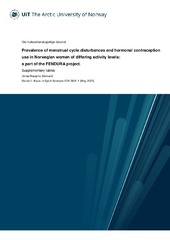| dc.description.abstract | <p>Background: A lack of research on female exercise physiology and sports psychology has resulted in considerable knowledge gaps regarding the optimal training methods and recommendations for the female athletic population, as current evidence is based primarily on research dominated by male participants. In order to conduct relevant and applicable research on the athletic female population, additional knowledge about female-specific factors is essential, such as current prevalence of hormonal contraceptive (HC) use and menstrual disorders (MD) in the female population.
<p>Purpose: This study investigated the prevalence of HC use and MDs in the Norwegian female population, stratified in activity groups from physically inactive to elite athletes. Due to earlier research exclusively focusing on the general female population or elite athletes, this study included a spectrum of sport- and age-categories, in order to provide descriptive prevalence data and investigate potential differences between these groups.
<p>Methods: To measure prevalence across different athletic levels and age groups requires a large sample size, and therefore a quantitative research approach (cross-sectional method) was chosen. A comprehensive questionnaire on HC use and MD occurrence was distributed across social media platforms and all Norwegian middle- and high schools. In total, 2027 Norwegian women completed the questionnaire containing questions regarding: demographics, use and type of HC, menstrual cycle function, physical activity volume, type of physical activity undertaken, and competitive athletic status.
<p>Results: The overall prevalence of HC use found in this study was 52.1% (n=1,056). There was no statistically significant differences across activity levels or sport groups, while females aged 20-29 showed a statistically higher HC use than participants aged 13-16 and 30-44 (p <.001). The prevalence of MDs in the study was 24.7% in non-HC users, although there were no statistically significant differences across activity levels, sport groups, or age groups. <p>Conclusion: This study provided important, cross-sectional data on the current HC use in Norway. Approximately half (51.2%) of sampled Norwegians currently used some form of HC; a considerably higher rate than previously reported in the female population. Future research on females should ensure the inclusion of HC-using participants, to permit the generalizability of results to a large proportion of the (HC-using) Norwegian population. The 24.7% prevalence of MD is lower than previous reported; however, primary amenorrhea is not included in this prevalence. | en_US |


 English
English norsk
norsk


